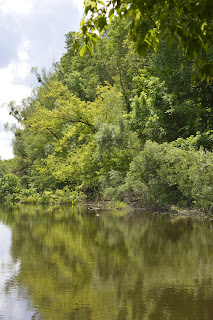Ready, steady, go! This boat row was at stand by when we reached the Külső-Béda, a narrow side stream of the Danube river. During the water body regulation of our major river many branch have been cut of from the main stream. This was to prevent the area of the constant flooding and to make the river a possible place for shipping companies.
I don't know who owns these boats but one can certainly arrange a short trip the Belső-Béda (Inner-Béda) is at the edge of the nearby village. It is possible to come here by coach and after a little walk right through the forest which leads to the Ramsar site, one can easily get to the waterbody.
Here I observed a Night heron (Nycticorax nycticorax) with my new binocular. I was not lucky enough to shoot a picture about this adult specimen however I could make an accurate observation.
The habitat is near to the village called Kölked, where we visited the White stork (Ciconia ciconia) museum (http://www.fehergolyamuzeum.hu/mainpage_en#). It was very good and well managed. The national park takes care of the museum and organizes specialized trips to explore the area's natural resources. Storks are not rare in this region and one can expect to see the endangered Black stork (Ciconia nigra) too.
I shortly interviewed the lady who let us in to see the exhibition and she told me that being a Ramsar site does not give much benefit, it is because the area is under national law enforcement. Personally I believe that being listed in the Ramsar Convention can give an extra help but this only can not stop habitat deterioration. Hungarian National Parks are well managed and kept in a good condition. The level of eco-tourism and the money gained from it could be improved.
We've seen several leisure anglers but not much. The water quality can be in a favorable condition as it is not managed yield fish for the market and no other major pollution source could be seen at the proximity.
The site is a shared site with Croatia as this area continues to our Southern neighbor. Every information leaflet and description board is in three languages so I was pretty amazed.
Some info about the site and a good old field car, typically known as TRABANT. It's like a sacred object these days and a funny flagship of the communist era.
The other side of the river has beautiful lawns, green as a pea. Unfortunately non of our black friends (C. nigra) were present.
We detected some perching trees and some guano underneath. This photo shows the dead tree accumulation along the river bank.
While at the field I have spotted the usual song bird fauna. To see more waterbirds it is wise to hire a canoe from the national park at the Külső-Béda (see the photo below).
Water directorate has some property at the edge of the site and the forest at the flood plain also owned by a larger organization. To have more information about the management of the site, one can gather certain information from this site: http://gemenczrt.hu/ (so far I did not find the English version).
The roads were surprisingly good. One can ride along the river at the top of the dam with a bike as it is completely paved.
Information boards like this say a few words about the avifauna and in general about the natural cornerstones of the discrete.














